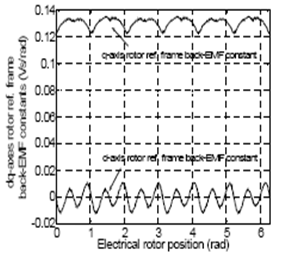ABSTRACT:
The permanent magnet synchronous motor (PMSM) has
emerged as an alternative to the induction motor because of the reduced size,
high torque to current ratio, higher efficiency and power factor in many
applications. Space Vector Pulse Width Modulation (SVPWM) technique is applied
to the PMSM to obtain speed and current responses with the variation in load.
This paper analysis the structure and equations of PMSM, SVPWM and voltage
space vector process. The Model Reference Adaptive System (MRAS) is also studied.
The PI controller uses from estimated speed feedback for the speed senseless
control of PMSM based on SVPWM with MRAS. The control scheme is simulated in
the MATLAB/Simulink software environment. The simulation result shows that the
speed of rotor is estimated with high precision and response is considerable
fast. The whole control system is effective, feasible and simple.
KEYWORDS:
1.
PMSM
2.
Space vector
pulse width modulation
3.
Model
reference adaptive system
SOFTWARE: MATLAB/SIMULINK
BLOCK DIAGRAM:
Fig. 1. Schematic Block of MRAS scheme
Fig. 2. Sensor less control block
diagram with MRAS system
EXPECTED SIMULATION RESULTS:
Fig.
3. Reference and real speed of PMSM
Fig.
4. Electromagnetic torque of PMSM
Fig.
5. Reference and real speed of PMS
Fig.
6. Electromagnetic torque of PMSM
Fig.
7. Reference and real speed of PMSM
Fig.
8. Electromagnetic torque of PMSM
Fig.
9. Reference and real speed of PMSM
Fig.
10. Electromagnetic torque of PMSM
CONCLUSION:
A
detailed Simulink model for a PMSM drive system with SVPWM based on model
reference adaptive system has being developed. Mathematical model can be easily
incorporated in the simulation and the presence of numerous toll boxes and
support guides simplifies the simulation. The space vector pulse width
modulation technique (SVPWM) control technique is used in PMSM drive which has
its potential advantages, such as lower current waveform distortion, high
utilization of DC voltage, low switching and noise losses, constant switching
frequency and reduced torque pulsations provides a fast response and superior dynamic
performance. Matlab/Simulink based computer simulation results shows that the
adaptive algorithm improve dynamic response, reduces torque ripple, and
extended speed range. Although this control algorithm does not require any integration
of sensed variables.
REFERENCES:
[1] Young Sam Kim, Sang Kyoon Kim, Young Ahn
Kwon, “MRAS Based Sensorless vontrol of permanent magnet synchronous motor”, SICE
Annual conference in Fukui, August 4-6,2003.
[2]
Xiao Xi, LI Yongdong, Zhang Meng, Liang Yan, “A Sensorless Control Based on
MRAS Method in Interior Pernanent-Magnet Machine Drive”, pp734-738, PEDS 2005.
[3]
Zhang Bingy, Cen Xiangjun et al. “A pposition sensor less vector control system
based on MRAS for low speeds and high torque PMSM drive”, Railway technology
avalanche, vol.1, no.1, pp.6, 2003.
[4]
P. Vas, “Sensorless Vector and Direct Torque Control”, Oxford University
Press, 1988.
[5]
A. K. Gupta and A. M. Khambadkone, “A Space Vector PWM Scheme for Multilevel
Inverters Based on Two-Level Space Vector PWM,” IEEE Transactions on
Industrial Electronics, vol. 53, no 5, pp. 1631-1639, Oct. 2006.







































